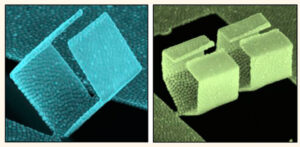
We introduce Plasmene; in analogy to graphene; as freestanding, one-particle-thick, superlattice sheets of nanoparticles (“meta-atoms”) from the “plasmonic periodic table”, which has implications in many important research disciplines. Here, we report on a general bottom-up self-assembly approach to fabricate giant plasmene nanosheets (i.e., plasmene with nanoscale thickness but with macroscopic lateral dimensions) as thin as ∼40 nm and as wide as ∼3 mm, corresponding to an aspect ratio of ∼75 000. In conjunction with top down lithography, such robust giant nanosheets could be milled into one-dimensional nanoribbons and folded into three-dimensional origami. Both experimental and theoretical studies reveal that our giant plasmene nanosheets are analogues of graphene from the plasmonic nanoparticle family, simultaneously possessing unique structural features and plasmon propagation functionalities. Given the generality of the concepts and methodologies established here, we believe that plasmene materials will lead to a wide range of scientific and technological applications, like flexible and stretchable plasmonics, foldable plasmonic devices, plasmonic waveguiding, switching and sensing, etc.
This work is supported by Discovery Grants, Melbourne Centre for Nanofabrication (MCN) in the Victorian Node of the Australian National Fabrication Facility (ANFF), Monash Micro Imaging Centre, Victoria India Doctoral Scholarship Program NSFC Grant.